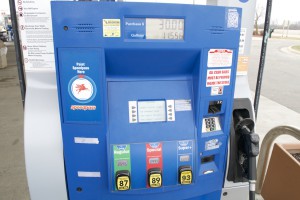
Gas prices are expected to rise if Hurricane Harvey makes landfall in Texas and Louisiana, as expected. (Photo credit: Brendan Strong)
With Labor Day, which marks the traditional end of summer driving season, fast approaching, gasoline prices dropped slightly this week, AAA reported. However, a hurricane expected to hit Texas and Louisiana in the next 24 hours now threatens to raise prices at the pump prior to holiday.
The petroleum industry is bracing for the impact of Hurricane Harvey, which is threatening both oil production in the Gulf of Mexico and refineries in an arc along the Gulf coast stretching from Houston to New Orleans.
The Gulf accounts to about 17% of the country’s total crude production and coastal Texas and Louisiana account for 45% of U.S. refining capacity.
Despite Harvey’s presence oil prices finished Thursday at their lowest level in a week even as the storm churned towards its expected landfall on the Texas Coast, according to Market Watch.
(Automakers expected to see sales rise in August. For the story, Click Here.)

Gas prices have been dropping with the end of the summer driving season. (Photo credit: Brendan Strong)
Futures based on oil and gasoline, however, moved up in early trading in Europe and overnight trading in the U.S., which indicates that an increase in gasoline prices is likely in the next few days as the petroleum industry copes with the aftermath of the storm, the Reuters news agency reported.
“Damage and flooding to refineries and shale fields, disrupted production in the Gulf of Mexico and infrastructure damage are unlikely to be bearish for WTI,” Jeffrey Halley, senior market analyst at futures brokerage OANDA, told Reuters.
Motorists have driven a record number of miles this summer, but inventories of gasoline have remained high, the U.S. Energy Information Agency reported this week, even though two key refineries on the Texas Coast have been shut — one for maintenance and the other by fire in recent days.
(To see more about Porsche and Ford being rated “ideal” by owners, Click Here.)
Meanwhile, AAA reported this week that at $2.33 per gallon, the national gas price average is two cents cheaper than a week ago. Consumers in most Midwest, East Coast and Southern states are paying, on average, two cents less on the week, while most West Coast and Rocky Mountain states are seeing pump prices increase on average by three cents.
The average price of gasoline is five cents per gallon more than a month ago and 17 cents more expensive than a year ago.
As gas prices continue to fluctuate across the country, growth in gasoline production combined with record-breaking high refinery runs continue to drive the country’s already relatively high gasoline inventories even higher.
(New vehicles costing Americans an additional $706 a month. To find out why, Click Here.)
The EIA reports that despite growing domestic and foreign demand, the national gasoline inventory levels sit at 231 million barrels and remain higher than the previous five-year average, AAA noted
